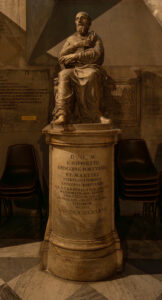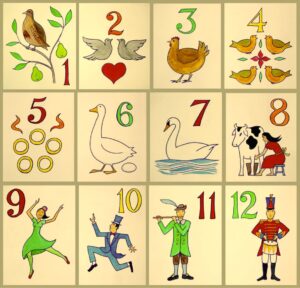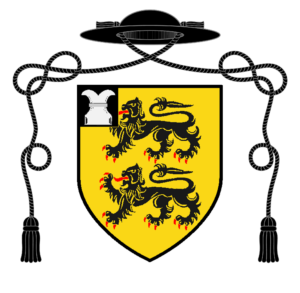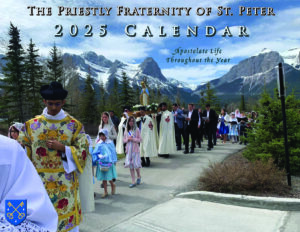The Easter Controversy and the Twelve Days of Christmas
by Fr. William Rock, FSSP
In chapter 11 of his The True Meaning of Christmas – The Birth of Jesus and the Origins of the Season (Fr. Rock recommended), Professor Michael Patrick Barber presents various theories of how and why December 25th was chosen as the date for the celebration of the Nativity of Our Lord. One of these, the Calculation Theory, Prof. Barber explains thus:
Ancient Attempts to Date Jesus’ Birth
Advocates of the Calculation Theory argue that early Christians decided on marking the Nativity of Jesus on December 25[th] due to complex chronological computations. There is clear evidence that supports this explanation; some certainly did this. However, as we shall see, this does not fully make sense of why December 25[th] was selected as the date of Christ’s nativity.
Jewish Traditions about the Births of Biblical Persons
It is often said that early Christians were influenced by a Jewish tradition that held that the great figures of Isreal’s past died on the day of their birth. This is sometimes called the “integral age” view. Evidence for this tradition can be found in the Babylonian Talmud, which dates to around A.D. 500. For example, the Talmud claims that Moses died on the anniversary of his birth [Qiddushin 38a]. It also reports opinions about the birth and death of Abraham and Jacob [Babylonian Talmud Rosh Hashanah 10b-11a]. While they disagree on the exact month, the rabbis agree that these patriarchs were born and died on the same month the world was created, though they are never said to have died on their birthdays. One teacher coordinates their births and deaths with the month Passover is celebrated. At another point, we are told that another patriarch, Isaac, was born on Passover.
By dying on the anniversary of their births, these men are said to have lived “the full measure” of their years. In connection with this, the Talmud cites the Scripture passage: “I will fulfill the number of your days” (Exodus 23:26). Many writers have believed that early Christians were influenced by these Jewish traditions and applied them to Jesus. This, however, is unclear. The Talmud dates to hundreds of years after the period we are examining. Whether Christians who were trying to determine the date of Jesus’s birth were influenced by the Jewish traditions described above is impossible to know.
Nevertheless, there are some parallels between what the rabbis said about the patriarchs and what is found in ancient Christian chronologists. For one thing, it does seem like calculations regarding Jesus’ conception or birth were connected to beliefs about when His death occurred.1

Now, despite the reservations Prof. Barber expressed, I favor the Calculation Theory because it has the most explanatory power in that it explains not only the December 25th date of Christmas, but also the January 6th date of Epiphany, and why there are Twelve Days between the two of them (points which Prof. Barber does not address directly). I do not have any better arguments than what Prof. Barber presented about the Christian use of such a method and its possible link to Jewish traditions, but regardless of the whys behind it, it seems that the early Christians did indeed use this method. But, to begin, we must discuss the date of Easter.
In the first few Christian centuries, the majority of the local Churches celebrated the Christian Pasch on a Sunday, claiming the authority of the Apostles Peter and Paul, while Churches in Asia Minor, claiming they were following a practice received from the Apostle John, associated the Christian Pasch with the celebration of the Jewish Passover on the 14th day of the Jewish Month of Nisan, regardless of on what day of the week it fell. Because of their practice, the members of this latter group were called Quartodecimans (14th-day-ers). It is important to note that at this time, the yearly liturgical observance of the Passion, Death, and Resurrection were all celebrated on the same day. Only later on would these be spread out over different days.2 So, the Churches in Asia Minor associated the Pasch with the date associated with Our Lord’s Passion and Death while the other Churches were associating it with the day of the Resurrection, Sunday.
Due to the complications in calculating the actual 14th of Nisan, a Quartodeciman sect fixed the date instead to “the fourteenth day of the first month in spring [which] was the equivalent of our 6 April.”3 It seems that from this, in the Christian East, the date of April 6th became regarded as the actual calendar date of the Crucifixion. Applying the Calculation Theory by setting April 6th as also the date of Our Lord’s Conception, and calculating nine months, we arrive at January 6th, the date of the Eastern Feast of the Theophany. First celebrated at “the end of the second [late 100s] or at the start of third century [early 200s],”4 the Feast of the Theophany commemorated various revelations of God through Christ, namely: “His Nativity, the homage of the Wise Men from the East, His Baptism, the miracle at Cana of Galilee and the miraculous multiplication of the loaves.”5 Over time, in the Christian East, the commemoration of Our Lord’s Baptism would predominate over the other mysteries.
There were other dates, however, which were also claimed to be the date of the Crucifixion and one of these dates was March 25th. On this point, Prof. Barber wrote:
the Canon [a work attributed to Hippolytus of Rome, part of which was inscribed on a Roman statue in A.D. 222] concludes that Jesus died on March 25[th] of the year 29. Tertullian, another second-century Christian writer, also fixes the Crucifixion to this date [Against the Jews 8, 18]. This agreement suggests that the date had found acceptance by at least some Christians.6

The arrival at this date in the Canon seems to be the result of attempting to determine the yearly Julian date of the 14th of Nisan including that of the year in which Our Lord was crucified.7 Be that as it may, this March 25th date for the Crucifixion was the one accepted by the Roman Church. In the Roman Martyrology, by way of supporting evidence, March 25th is indicated as the day of death of the Good Thief who, of course, died on the same day as Our Lord. Applying the Calculation Theory by setting March 25th as also the date of Our Lord’s Conception, and calculating nine months, we arrive at December 25th, the date on which the Roman Church has celebrated the Feast of the Lord’s Nativity since at least A.D. 335-6.8 During this time, however, Greek Christians in Rome celebrated the Theophany on January 6th and kept December 25th as the Feast of St. Anastasia at the church named after her in the city.9
In the course of time, due to liturgical cross-pollination,10 the majority of Eastern Churches eventually accepted the Roman date of December 25th for the Feast of Our Lord’s Nativity while retaining the Feast of the Theophany, which now no longer commemorated the Nativity. The December 25th date “was introduced at Antioch, ab. 375; Constantinople, ab. 379; Jerusalem, 424-458; and Alexandria, ab. 430.”11 The Roman Church, for its part, adopted a January 6th Nativity-less Feast of the Theophany, more commonly called in the West the Feast of the Epiphany. In the western tradition, while the Office of the day does mention other mysteries, the Mass of Epiphany on January 6th, unlike in the East, focuses on the Visitation of the Magi, not the Baptism. Our Lord’s Baptism is the focus of the Mass on the Octave Day of the Epiphany, January 13th, the second mystery of the western Epiphany. The Gospel for the Mass of the Second Sunday after Epiphany relates Our Lord turning water into wine at the wedding feast, the third mystery of the western Epiphany. It is important to note here that while the Feast of the Theophany/Epiphany is the older feast absolutely, the Feast of the Nativity of Our Lord is older in the Roman tradition.

As the devotion towards St. Anastasia in Rome declined, the Mass celebrated at St. Anastasia church became a Mass of Christmas with a commemoration of St. Anastasia.12 Today, this Mass, along with the commemoration, is the Second Mass, or Dawn Mass, of Christmas, celebrated after the Office of Prime. The First Mass of Christmas, the Midnight Mass (which is not a Vigil Mass), celebrated after the Office of Matins, was instituted in imitation of the ceremonies carried out by the Church of Jerusalem. What is now known as the Third Mass of Christmas, the Day Mass, celebrated after the Office of Terce, reflects the original Roman Mass of the day.13 These three Christmas Masses, then, represent/reflect Hierosolymitan, Greek, and Roman liturgical traditions. Additionally, perhaps due to the Nativity previously being celebrated as part of the Feast of the Theophany, one of the readings of the Byzantine Church on December 25th is the Visitation of the Magi (Matt 2:1-12).14 Traditionally, the proper Last Gospel for the Roman Third Mass of Christmas is also the Visitation of the Magi (Matt 2:1-12), as the Prologue of St. John is the Gospel of the Mass. Perhaps this choice was influenced by the Greek practice.
To further support the Calculation Theory, it ought to be pointed out that the Armenian Orthodox Church never adopted the Roman date for the celebration of Our Lord’s Nativity. As such, the Armenian Orthodox Church still celebrates Our Lord’s Conception on April 7th and His Birth on January 6th.15

Now, some confusion may arise if one were to look at a modern calendar and notice that January 7th is marked as Orthodox Christmas. Should not Orthodox Christmas be December 25th? The discrepancy comes from a difference in calendars and how December 25th is determined.16 Originally, both the Latin and Greek Christians used the Julian Calendar. But, when the Catholic Church adopted the Gregorian Calendar in A.D. 1582, ten days were removed from the calendar. Since the Gregorian Calendar was not adopted by the Orthodox Churches, the Western and Eastern celebrations of fixed feasts then differed by ten days. Due to the particularities of each calendar, this difference has increased over time. To makes matters even more complicated, some Orthodox Churches have adopted a revised Julian calendar in which the fixed feasts now correspond to the Gregorian dates, such as Christmas, but the moveable feasts, such as Easter, still fall on the original Julian dates.17 The Armenian Orthodox Church, outside of Jerusalem, adopted the Gregorian Calendar.18 So, there are now currently five dates for the Feast of the Nativity:
- Gregorian December 25th (Western Christians)
- Julian December 25th / Gregorian January 7th (some Eastern Christians)
- Revised Julian December 25th / Gregorian December 25th (some Eastern Christians)
- Gregorian January 6th (most Armenian Orthodox)
- Julian January 6th / Gregorian January 19th (Armenian Orthodox in Jerusalem)
For their part, the Twelve Days of Christmas observed both by Latin and Eastern Christians (except the Armenians), counting inclusively starting on Christmas day itself and ending on the day before the Epiphany (December 25th to January 5th), recognized already in A.D. 566-7 by the Second Council of Tours as a sacred time (can. xi, xvii),19 resulted from the above mentioned cross-pollination of two different liturgical traditions which originally commemorated Our Lord’s Birth on two different days calculated from two different days presumed for Our Lord’s Crucifixion, which were also presumed to be the days of His Conception, which happened to be this many days apart. They are, in a sense, an echo (or scar) in the Church’s liturgy of the great Easter Controversy from the early Christian centuries.20
Fr. William Rock, FSSP was ordained in the fall of 2019 and is currently assigned to St. Stanislaus Parish in Nashua, NH.
In support of the causes of Blessed Maria Cristina, Queen, and Servant of God Francesco II, King
- Barber, Michael Patrick. The True Meaning of Christmas – The Birth of Jesus and the Origins of the Season. (San Francisco: Ignatius Press, 2021), pp. 156-7.
- Goddard, Philip J. Festa Paschalia – A History of the Holy Week Liturgy in the Roman Rite. (Leominster: Gracewing, 2011), p. 21.
- Ibid., p. 19
- Katrij, Julian. A Byzantine Rite Liturgical Year. Trans. Wysochansky, Demetrius. (Detroit: Basilian Fathers Publication, 1983), p. 344.
- Ibid., p. 342.
- Barber, p. 160.
- Talley, T. J. The Origins of the Liturgical Year. (New York: Pueblo Books, 1986), p. 9.
- Denis-Boulet, Noele M. Twentieth Century Encyclopedia of Catholicism, Section X – The Worship of the Church, vol. 113 – The Christian Calendar. Trans. Hepburne-Scott, P. (New York: Hawthron Books, 1960), p. 50. Another theory is that the date of 25 December was chosen to coincide with the Winter Solstice. When the Julian calendar was originally promulgated, it was so arranged that 25 December would correspond with the Winter Solstice and 25 March with the Spring Equinox and as such 25 December was kept as the observed Winter Solstice and 25 March as the observed Spring Equinox and so on for the other two. However, due to the defects of the Julian calendar, the observed dates had drifted from their respective astronomical events by several days. The First Council of Nicaea held in A.D. 325, without correcting the defects of the Julian calendar, shifted the observed date of the Spring Equinox to 21 March and thus that of the Winter Solstice to 21 December, and so on for the other two, so that they aligned, at least for the time being, with their respective astronomical events (Old Catholic Encyclopedia, s.v. “Reform of the Calendar”). As was said in the body, the Roman Church has celebrated the Feast of the Lord’s Nativity on 25 December since at least A.D. 335-6. All the previous being taken into account, in order for the Winter Solstice theory to be applicable, the date of 25 December would have had to been chosen before the A.D. 325 Nicaean shift of the Equinoxes and Solstices, and, also, this date would have had to be retained after the shift.
- Schuster, Ildefonso. The Sacramentary, vol. I. Trans. Levelis-Marke, Arthur. (Waterloo: Arouca Press, 2020), p. 363.
- Denis-Boulet, p. 57-58.
- King, Archdale. The Rites of Eastern Christendom, vol. II. (Piscataway: Gorgia Press, 2007), p. 574, n. 135
- Schuster, p. 363.
- Ibid., pp. 362-4.
- “Matthew 2, 1-12, which is also read at the Divine Liturgy of Christmas. (In the Byzantine Rite, the feast of the Epiphany is wholly dedicated to the Lord’s Baptism, and the adoration of the Magi is read as the Gospel of Christmas day.)” New Liturgical Movement: The Royal Hours of Christmas Eve
- King, pp. 574-575. Also Berber, p. 148.
- See Berber, p. 148.
- The Revised Julian Calendar
- The Armenian Apostolic Church – Calendar and Feast Days
- Old Catholic Encyclopedia, s.v. “Christmas.”
- Goddard, p. 25, n. 45 – “The notion that 25 March or 6 April was the date of the Crucifixion seems to have governed the celebration of the Nativity either on 25 December or 6 January, following the commonly held belief that Christ’s earthly life began and ended on the same date.” See also Talley, pp. 129-130.
January 1, 2025









